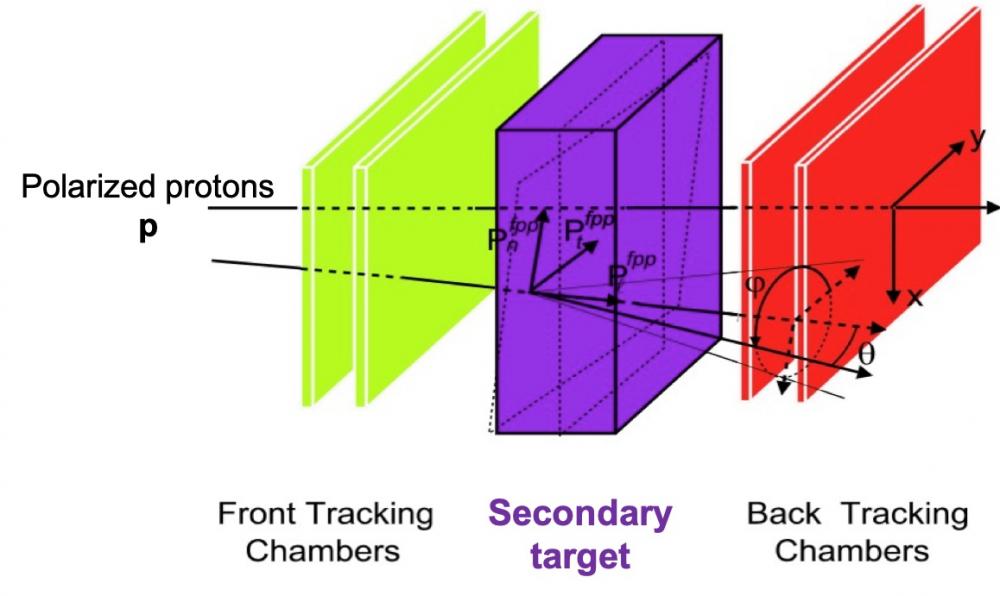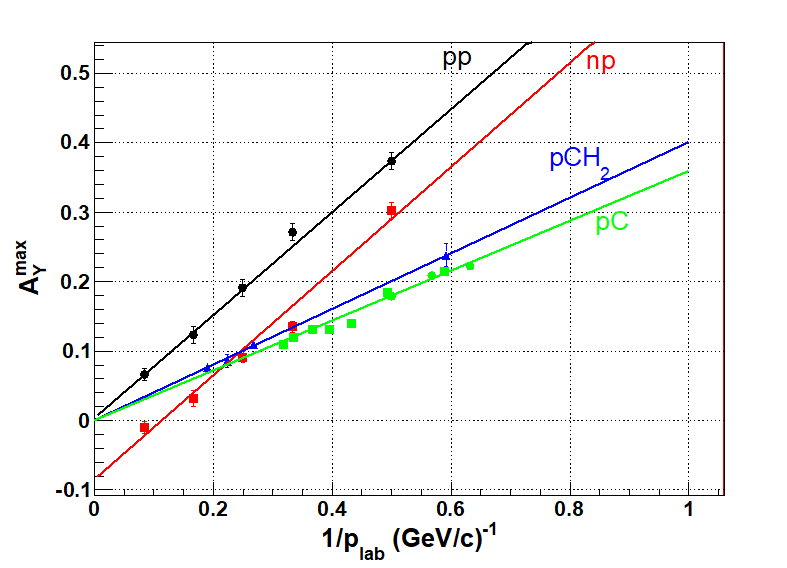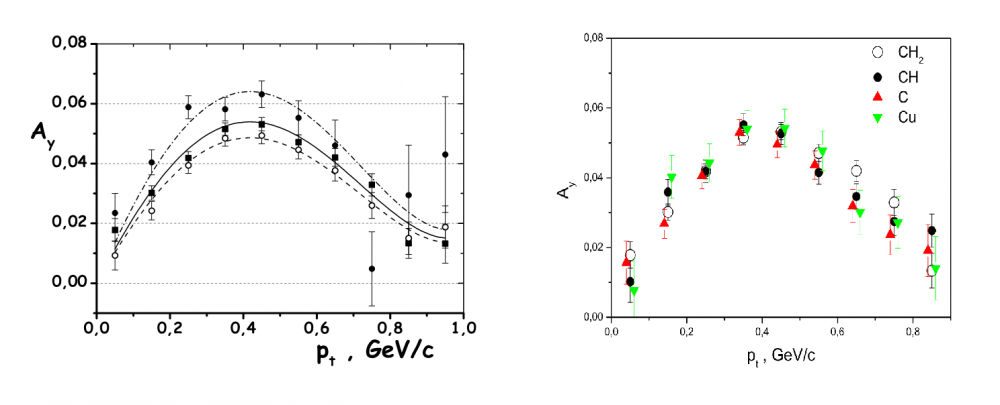Nucleons (protons and neutrons), the components of the atomic nucleus, can be polarized. This means that their spins are preferentially aligned along a quantization axis. The spin is a quantum property of a particle and has its classical analogue in a spinning top. The strong interaction that acts among nucleons in the atomic nucleus is sensitive to the polarization. Therefore, for a better understanding of the strong interaction, it may be interesting to measure the polarization of the particles produced in a nuclear reaction. The devices to measure the polarization are called polarimeters. Conceiving, building, testing and validating polarimeters requires proton and neutron polarized beams, of known polarization. Today, such beams of energy in the GeV range are available only at the Nuclotron complex of JINR, Dubna, in Russia. In order to optimize neutron and proton polarimetry at energies of few GeV, analyzing powers have been measured with Nuclotron beams on different targets: Carbone, mylar, paraffine, as well as on a heavier target, cupper, for beam momenta in the range 3 – 4.2 GeV/c. The present work indicates that high-energy polarimetry shows specific characteristics, opening the way to innovative experimental approaches. These results have been published in EPJA, as ‘Special article’, section ‘New Tools and Methods’ [1].
Several experiments at the Jefferson Laboratory (JLab, USA) need the measurement of proton and neutron polarization of the particles produced in the reaction of interest. Consider for example polarized electron proton elastic scattering with polarized particles: physical observables are very sensitive to theoretical models. In particular, a unique method, suggested by A.I. Akhiezer et M.P. Rekalo [2] to precisely measure the ‘electric and magnetic form factors’, which describe the charge distributions within the proton [3,4], requires the measurement of the recoil proton polarization in elastic electron-proton scattering:
e+p →e+p (1)
A polarized electron beam interacts with a proton target and the polarization in the scattering plane of the emitted proton is measured. Similarly, the polarized electron beam can be sent on neutrons within a target, and the recoil neutron polarization is measured.
The particles, produced in the reaction of interest, the polarization of which has to be known as the recoil protons of reaction (1), cross the polarimeter, usually set at the focal plane of a spectrometer. An example of polarimeter is sketched in figure 2. This polarimeter is constituted by a detection system of the trajectories before (green) and after (red) a secondary target (purple). The precise reconstruction of these trajectories allows to measure the left/right (top/down) asymmetries of the secondary reaction products (with an unpolarized beam, the reaction products would be emitted with a cylindrical symmetry around the beam axis). More precisely, it is the azimuthal asymmetry along the angle (φ) that allows reconstructing the polarization of the particle impinging on the polarimeter. Therefore, the polarization is measured by the « asymmetry of the azimuthal distribution in a secondary reaction ». The nature of the secondary target, its thickness, as well as the geometry of the polarimeter, has to be optimized at each energy.

Figure 2: Scheme of a polarimeter. The detection system of the trajectories before(after) the secondary target is shown in green(red). The secondary target(violet) lies in the focal plane of a spectrometer. The longitudinal (PL), transverse (PT) and normal (PN) components of the incoming proton polarization are defined with the help of the polar (theta) and azimuthal (phi) angles.
Polarization measurements are very difficult, as the trajectories must be known with very high precision, as well as the eventual experimental asymmetries (due to a misalignment of the detection for example). They need long beam-time as two successive reactions are necessary: i) the primary reaction, producing the particle which polarization has to be known; ii) the second interaction with the polarimeter target to measure its polarization. The second reaction has to be simple for identification and very sensitive to the particle polarization, what is quantified by two observables: 1) the cross section, which characterizes the probability that such reaction occurs 2) the analyzing power, that quantifies the sensitivity of the reaction to the polarization of the incoming particles.
To determine the analyzing power of a polarimeter, one measures the azimuthal asymmetry of the detected particles with a beam of known polarization (even for experiments at electron accelerators, a proton or a neutron beam is therefore necessary for the calibration step!). The first JLab experiments took benefit of the results obtained in the 1990’s at ‘ Laboratoire National Saturne’, in Saclay. With polarized protons to 3 GeV/c and polarized neutrons to 1.9 GeV/c, it was shown that a thick carbon or mylar target with the detection of a charged particle was sufficient to build an effective polarimeter. They also showed that analyzing powers decrease when the energy grows. This is mostly due to the fact that other reactions, producing several charged particles, and not carrying information on the polarization, become more probable. The maximum value of the analyzing power Ay shows a linear behavior as a function of the inverse of the momentum, 1/pLab (Fig. 3).

Figure 3: Dependence of the maximum value of the analyzing power Aymax, as a function of the inverse of the incident momentum of protons and neutrons on different targets. Aymax decreases when the momentum increases. Each color correspond to a definite projectile (p,n)-target(p,C,CH2). Aymax decreases when the beam momentum increases.
Due to this dependence, for the high-energy measurements planned at JLab, it is necessary to develop new generation polarimeters and compare their performances in the required kinematical conditions. At JINR, in Dubna, Russia, polarized deuterons1 can be accelerated up to 13 GeV/c momenta. Neutron and proton beams are obtained by break-up on a Beryllium target, with half momentum (~ 7 GeV/c) and complete polarization transfer (i.e., the polarization degree is the same in the deuteron beam and in the break-up products). A program of systematic measurements of analyzing powers is endorsed by the ALPOM2 collaboration, that gathers about thirty physicists from Russia, USA, FRANCE, Slovakia, and Scotland. The POMME polarimeter working at Saturne (in its different versions including even a large liquid hydrogen target (HYPOM) [5]!) has been transferred to the High Energy Laboratory (VBLHEP) at JINR, after closing Saturne.
The obtained results with the JINR polarized neutron beam are shown on the figure 4: for different targets at 3.75 GeV/c (left); for the CH2 target and different momenta (right) pLab = 3, 3.75 et 4.2 GeV/c. This is the first measurement of analyzing powers on heavy ions (other than hydrogen targets) as well as on thick targets with a neutron beam. The analyzing power, Ay, follows a bell curve, (slightly decreasing when the beam momentum increases, figure 4, right) and it is comparable for different targets: C, CH, CH2, Cu (figure 4, left). The Cu target works equally well as light targets, what largely simplifies the polarimeter geometry, as the target thickness is smaller for the same number of atoms.

Figure 4. Left: Analyzing powers for the reaction induced by polarized neutrons of 3.75 GeV/c on different targets. No systematic effect depending on the target mass is observed. Right: Analyzing powers for the reaction induced by polarized neutrons on the CH2 target for different momenta: 3 GeV (solid circles), 3.75 GeV (solid squares), 4.2 GeV (empty circles). The analyzing power decreases slightly when the beam momentum increases.

Figure 5: Analyzing powers for p+Cu (squares) and the charge exchange n+Cu (circles), with detection of a charged particle in the calorimeter, before(solid symbols) and after(open symbols) selection on the energy deposit by the produced charged particle detected in the calorimeter.
The charged particles produced in the secondary target are detected in a calorimeter (the downstream detector). The impact of the selection on the energy deposit in the calorimeter is shown in figure 5. One can see an increase of a factor of 1.3 for the reaction induced by the proton beam and a factor of 2 for the charge-exchange reaction2, induced by the neutron beam.
Summarizing, the results show three new characteristics, particularly interesting in the considered momentum range:
Such results show that it is still possible to conceive high-energy polarimeters, and therefore to pursue relevant JLab experiments after the upgrade. The ALPOM2 collaboration plans to continue this program up to the largest beam momenta that will be available in Dubna.
1. A deuteron is composed by a proton and a neutron. It is an isotope of the hydrogen.
2. Contrary to elastic scattering, where the outgoing particles are the same as the incident ones, in a neutron induced charge- exchange reaction a proton is detected forward.
References:
[1] S. N. Basilev et al., Eur. Phys. J. A 56, 26 (2020).
[2] A.I. Akhiezer and M.P. Rekalo, Sov.J. Part. Nucl. 4, 277 (1974).
[3] C.F. Perdrisat et al., JLab Exp. E12-07-109 (2007).
[4] J.R.M. Annand et al., JLab Exp. E12-17-004 (2017).
[5] L.B. Golovanov et al., Nucl. Instrum. Meth. A430 (1999) 1-9.
Contact: Egle Tomasi-Gustafsson Irfu/DPhN
